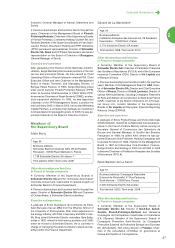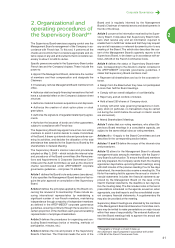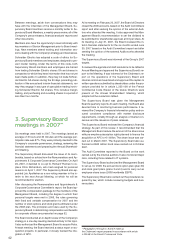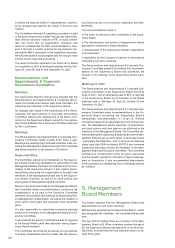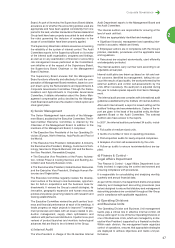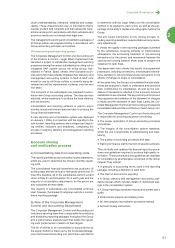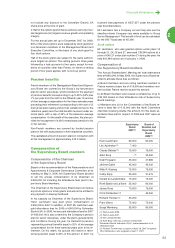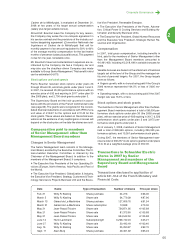APC 2007 Annual Report Download - page 48
Download and view the complete annual report
Please find page 48 of the 2007 APC annual report below. You can navigate through the pages in the report by either clicking on the pages listed below, or by using the keyword search tool below to find specific information within the annual report.
46
The purpose of these internal control procedures is to en-
sure:
Compliance with laws and regulations.
Application of instructions and guidelines issued by Sen-
ior Management.
The proper functioning of the Company’s internal
processes, notably as concerns asset preservation.
Reliable financial information.
More generally, internal control helps the Group manage
its businesses, run efficient operations and use its re-
sources efficiently.
Because it is designed to prevent and control risks that
could keep the Company from achieving its targets, inter-
nal control plays a key role in management of operations.
No system of internal control designed to fulfill the above
objectives is capable of providing absolute assurance that
the objectives will be met due to the inherent limitations of
procedures, however well conceived. The internal control
process is a work in progress; procedures are adapted to
reflect changes in the business and regulatory environ-
ment, as well as in the Group’s organization. The different
participants in the process ensure that procedures are reg-
ularly updated and circulated throughout the Group.
This report was prepared on the basis of discussions
among these participants, in particular Finance & Control
- Legal Affairs, Senior Management and the internal audi-
tors. It is supported by a review of the internal control re-
sources and procedures deployed by the Group.
Internal Control
Organization
Control environment: key
participants and responsibilities
a) Supervisory Board, Audit Committee
and Remunerations and Appointments &
Corporate Governance Committee
In accordance with article L.225-68 of the French Com-
mercial Code, the Supervisory Board exercises permanent
oversight over the Company’s management by the Man-
agement Board, which has the broadest powers in relation
to third parties to act in all circumstances in the Company’s
name.
In addition to performing ex-post controls as part of its
oversight activities, the Supervisory Board also performs
ex-ante controls, particularly in the areas of financing and
the implementation of Group strategy. The Company’s by-
laws and the Supervisory Board’s internal rules state that
the Management Board must obtain the Supervisory
Board’s prior authorization before carrying out any debt or
equity financing transactions that would significantly alter
the Company’s balance sheet structure, or before decid-
ing any material business acquisitions or disposals.
The Supervisory Board’s ex-post controls include review-
ing the financial statements approved by the Management
7. Declarations
concerning the situation
of the members of the
Supervisory Board and
Management Board
The members of the Supervisory Board and Management
Board together hold 0.03% of the Company’s capital and
0.03% of the voting rights.
Pierre Bouchut has service contracts with Schneider Elec-
tric Industries S.A.S. and Schneider Electric Services In-
ternational.
Alain Burq has a service contract with Schneider Electric
Industries S.A.S.
None of the members of the Supervisory Board or Man-
agement Board has a service contract with the Company
or any of its subsidiaries providing for benefits upon termi-
nation of employment.
No related-party agreements have been entered into be-
tween the Company and the members of the Supervisory
Board or Management Board.
In the last five years, none of the members of the Supervi-
sory Board or Management Board have been:
The subject of any convictions in relation to fraudulent of-
fences or of any official public incrimination and/or sanc-
tions by statutory regulatory authorities.
Disqualified by a court from acting as a member of the
administrative, management or supervisory bodies of an
issuer or from acting in the management or conduct of the
affairs of an issuer.
Involved, as a member of an administrative, manage-
ment or supervisory body or a partner, in a bankruptcy, re-
ceivership or liquidation.
None of the members of the Supervisory Board or Man-
agement Board are related to each other.
There are no arrangements or understandings with major
shareholders, customers, suppliers or others pursuant to
which a member of the Supervisory Board or Management
Board has been selected as a member of an administra-
tive, management or supervisory body or a member of
Senior Management.
There are no conflicts of interests between any duties to
Schneider Electric SA of the members of the Supervisory
Board or Management Board and their private interests.
8. Internal Control **
In its operations, Schneider Electric faces a number of ex-
ternal and internal risks presented in the description of the
Company and its businesses (see pages 28 to 33). The
Group has set up procedures and processes to identify,
quantify and reduce these risks in order to prevent and
manage them effectively. It has also established proce-
dures at Group level to anticipate and control the risk of
accounting and other errors and fraud.
**Paragraphs 2 through 4, 8 and 9 make up
the Chairman’s report prepared in accordance with article
L.225-68 of the French Commercial Code.



